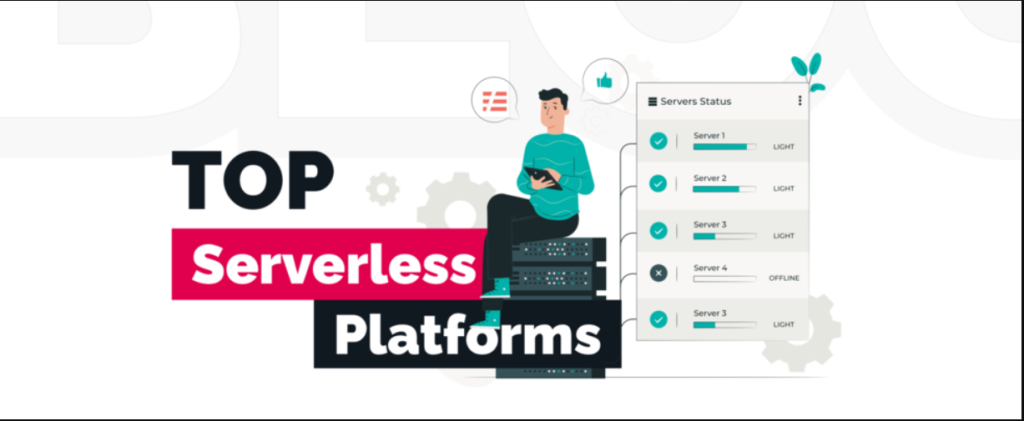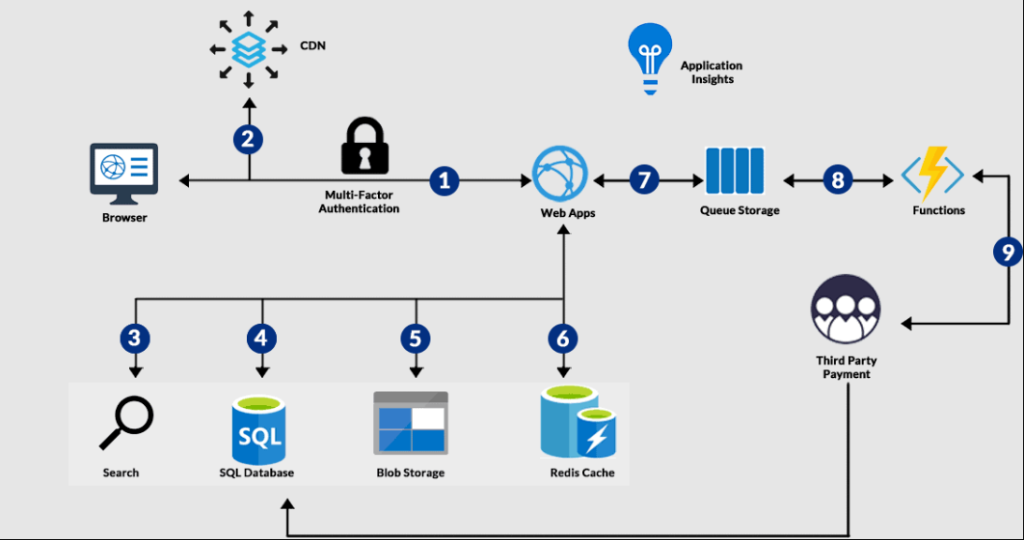
Here’s a comprehensive post titled “Top Serverless Platforms in 2025: AWS Lambda, Azure Functions & More” with expanded content for each section:
The Growing Popularity of Serverless Computing
Serverless computing is one of the fastest-growing trends in cloud development, enabling developers to focus on writing code while cloud providers handle the infrastructure management. In serverless architectures, applications are broken down into smaller, event-driven functions that scale automatically based on demand. This eliminates the need for developers to manage servers or worry about scaling infrastructure, leading to more efficient, cost-effective, and scalable applications.
In 2025, serverless platforms have become more advanced, offering an array of features that support the development of complex, scalable cloud-native applications. The top serverless platforms, including AWS Lambda, Azure Functions, Google Cloud Functions, and others, have significantly improved their capabilities, providing developers with powerful tools to accelerate development and optimize costs.
Key Features of Serverless Platforms
- Event-Driven Execution: Functions are executed in response to events such as HTTP requests, file uploads, or database changes.
- Scalability: Serverless platforms scale automatically based on demand, ensuring optimal performance during high traffic periods.
- Cost-Effective: Serverless follows a pay-per-use pricing model, charging only for the compute time used, without the need to pay for idle resources.
- Zero Infrastructure Management: Developers don’t need to manage servers or provision infrastructure, which reduces operational complexity.
- Flexible Integration: Serverless platforms can integrate seamlessly with other cloud services to build robust, cloud-native applications.
1. AWS Lambda: The Industry Standard
AWS Lambda is one of the most widely used serverless platforms and continues to be a leading choice for businesses looking to build scalable, event-driven applications. It offers a wide range of features and integrations, making it the go-to platform for many developers working in the AWS ecosystem.
Key Features of AWS Lambda
- Multi-Language Support: Lambda supports a broad range of programming languages, including Python, Node.js, Java, Go, Ruby, and C#, making it versatile for many use cases.
- Seamless AWS Integration: Lambda integrates smoothly with other AWS services, including S3, DynamoDB, SNS, and API Gateway, enabling the creation of complex serverless applications with minimal configuration.
- Automatic Scaling: AWS Lambda automatically scales the number of function instances based on incoming traffic, ensuring applications can handle increased load without manual intervention.
- Granular Billing: Lambda uses a pay-per-use model based on the number of requests and the execution time of the functions, which ensures that you only pay for what you use.
- Resource Management: AWS Lambda allows developers to allocate specific resources, such as memory, for each function, optimizing performance for various workloads.

2. Azure Functions: A Microsoft Solution for Serverless Computing
Azure Functions is Microsoft’s serverless offering and is widely used by enterprises that rely on Azure’s ecosystem. Azure Functions offers a powerful and flexible serverless platform that integrates well with Azure’s cloud services, such as Event Grid, Cosmos DB, and Service Bus. It provides different hosting options to cater to different needs, from event-driven functions to long-running workflows.
Key Features of Azure Functions
- Multiple Hosting Plans: Azure Functions offers a Consumption Plan (pay-per-execution) and a Premium Plan (providing more control over resources and scaling), allowing businesses to choose the most suitable option based on their needs.
- Built-in Integrations: Azure Functions integrates with Azure’s services like Azure Event Grid, Cosmos DB, Logic Apps, and Service Bus, making it a natural choice for organizations already invested in the Azure ecosystem.
- Language Support: Azure Functions supports C#, JavaScript, Python, Java, PowerShell, and TypeScript, allowing developers to choose the language best suited to their needs.
- Trigger-Based Execution: Functions can be triggered by a variety of events, including HTTP requests, file uploads, and database updates, giving developers flexibility in building event-driven systems.
- Rich Developer Tools: Azure Functions provides a comprehensive suite of development tools, including integration with Visual Studio and GitHub, to support continuous integration and deployment (CI/CD) pipelines.
3. Google Cloud Functions: Flexible and Easy to Use
Google Cloud Functions offers a lightweight, flexible serverless computing platform that is particularly well-suited for developers building cloud-native applications. It allows developers to run code in response to HTTP requests, events from Google Cloud Storage, or changes in Google Firestore or Google Pub/Sub. Google Cloud Functions is a strong option for developers looking to build quick, efficient, event-driven systems.
Key Features of Google Cloud Functions
- Ease of Use: Google Cloud Functions is known for its simplicity and easy-to-use interface, making it ideal for both new developers and experienced teams looking to quickly implement serverless solutions.
- Seamless Google Cloud Integration: Cloud Functions integrates seamlessly with other Google Cloud services such as Google Cloud Storage, Pub/Sub, BigQuery, and Firestore, enabling a cohesive cloud-native experience.
- Automatic Scaling: Google Cloud Functions automatically scales based on the number of incoming events, ensuring that applications can handle varying levels of traffic efficiently.
- Flexible Billing: Similar to other serverless platforms, Google Cloud Functions charges based on the number of requests and execution time, making it a cost-effective choice for applications with unpredictable traffic.
- Event-Driven Architecture: Cloud Functions supports various event sources, including file uploads, database changes, and HTTP requests, making it suitable for real-time applications and microservices.
4. IBM Cloud Functions: Open Source and Highly Customizable
IBM Cloud Functions is built on Apache OpenWhisk, an open-source serverless framework, and offers significant flexibility and customization for developers. With support for multiple runtimes and frameworks, IBM Cloud Functions allows developers to create highly customizable serverless functions that integrate seamlessly with IBM’s cloud ecosystem, including IBM Watson, IBM Blockchain, and IBM Cloud Object Storage.
Key Features of IBM Cloud Functions
- Open-Source Foundation: As an open-source platform built on Apache OpenWhisk, IBM Cloud Functions offers more flexibility in managing and customizing serverless workloads compared to some other platforms.
- Multiple Language Support: IBM Cloud Functions supports a wide range of programming languages, including Node.js, Python, Java, Swift, PHP, and Go, making it adaptable to various use cases.
- Event-Driven Execution: Cloud Functions can be triggered by a wide variety of events, including IBM Cloud Object Storage, Cloudant, Kafka, and HTTP requests, enabling efficient event-driven workflows.
- Automatic Scaling: Like other serverless platforms, IBM Cloud Functions scales automatically based on the number of requests, ensuring optimal performance during high demand periods.
- Integration with IBM Services: IBM Cloud Functions integrates seamlessly with IBM Watson for AI and machine learning, IBM Blockchain for distributed ledger technologies, and IBM Cloud services for secure data storage and processing.
5. Alibaba Cloud Function Compute: Cost-Effective and Scalable
Alibaba Cloud Function Compute is Alibaba’s serverless platform, designed to scale applications dynamically and efficiently while reducing costs. It is particularly popular in the Asia-Pacific region and provides excellent integration with other Alibaba Cloud services like OSS, MNS, and API Gateway.
Key Features of Alibaba Cloud Function Compute
- Seamless Alibaba Cloud Integration: Function Compute integrates with other Alibaba Cloud services such as OSS, MNS, API Gateway, and Log Service, making it ideal for businesses using Alibaba Cloud.
- Auto-Scaling and Load Balancing: Function Compute automatically scales up or down based on the workload, ensuring that your application performs optimally, even during peak traffic periods.
- Multiple Event Triggers: Alibaba Cloud Function Compute supports multiple event triggers, including HTTP requests, file uploads, and database changes, making it suitable for various use cases.
- Pay-Per-Use Pricing: Alibaba Cloud uses a consumption-based pricing model where businesses only pay for the actual compute time and storage used, leading to significant cost savings for variable workloads.
- Global Reach: With data centers in regions such as Asia, Europe, and North America, Alibaba Cloud Function Compute provides global scalability, ensuring low-latency access for users around the world.
6. Key Considerations When Choosing a Serverless Platform
While the above platforms offer powerful capabilities, choosing the right serverless platform for your needs requires careful consideration of several factors. The ideal platform depends on your use case, budget, and the tools you already use in your development workflow.
Considerations When Choosing a Serverless Platform
- Integration with Existing Cloud Services: If your organization is already heavily invested in a particular cloud provider, choosing a serverless platform that integrates seamlessly with your existing cloud services (e.g., AWS, Azure, Google Cloud) can simplify the development process.
- Cost Structure: Different serverless platforms offer varying pricing models, so it’s important to calculate costs based on expected usage. Pay-per-use models are common, but pricing for request volume, execution time, and storage can vary widely across providers.
- Performance and Latency: Evaluate the performance and latency of serverless functions on each platform. For example, some platforms may offer faster cold start times or more efficient scaling during peak demand.
- Security and Compliance: Make sure the serverless platform supports the necessary security features, such as encryption, identity and access management (IAM), and compliance with regulations (e.g., GDPR, HIPAA).
- Developer Tools and Ecosystem: Consider the developer tools and ecosystem available on each platform. Platforms like AWS Lambda and Azure Functions offer extensive support for CI/CD, monitoring, and logging, which can make managing serverless applications easier.
Choosing the Right Serverless Platform
Serverless computing has transformed the way developers build and deploy applications, offering unparalleled scalability, cost efficiency, and flexibility. As we move into 2025, the major cloud providers continue to enhance their serverless offerings, providing businesses with powerful tools to build event-driven applications that scale automatically.
Whether you choose AWS Lambda, Azure Functions, Google Cloud Functions, IBM Cloud Functions, or Alibaba Cloud Function Compute, each platform offers unique advantages. The key is to assess your business needs, technical requirements, and budget to determine which platform aligns best with your goals. By choosing the right serverless platform, you can leverage the benefits of serverless computing to accelerate development, improve performance, and reduce costs in 2025 and beyond.
